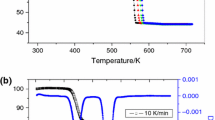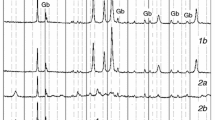Abstract
The environment can influence the thermal decomposition of an oxysalt by;
-
(a)
causing a change in the course of chemical decomposition or
-
(b)
causing an alteration in the physical nature of the solid product or solid intermediates.
The environment can also effect the equilibrium condition or the course of the kinetics. The use of special techniques such as thermogravimetry, differential thermal analysis, or differential scanning calorimetry to study the decomposition means that a special environment is imposed on the oxysalt and this effects the thermal decomposition process.
The influence of the environment in changing the course of a chemical reaction can be illustrated by reference to the decomposition of zinc oxalate and nickel oxalate. The DTA shows that the decompositions are endothermic in inert atmospheres but exothermic in air or oxygen. The reasons are different however in each case. Thus although the product of decomposition of zinc oxalate is zinc oxide the change in character of the decomposition from endothermic to exothermic is due to the catalytic oxidation of carbon monoxide to carbon dioxide in the presence of oxygen. The similar change in the character of nickel oxalate decomposition is however due to nickel formation in an inert atmosphere but nickel oxide in air or oxygen.
The alteration in the physical nature of the solid products is illustrated by surface area measurements on solid residues from the decomposition of carbonates or oxalates. The kinetic and chemical equilibrium studies showing the influence of environment are illustrated by reference to dehydration studies, carbonate and oxalate decompositions.
Résumé
L'environment peut influer sur la décomposition thermique d'un oxysel en provoquant: a) un changement pendant la décomposition thermique, b) une altération de la nature physique du produit solide ou des phases intermédiaires solides.
L'environment peut aussi exercer un effet sur les conditions d'équilibre ou sur la cinétique. L'emploi de techniques spéciales, comme la thermogravimétrie, l'analyse thermique différentielle ou l'analyses calorimétrique différentielle (DSC), pour étudier la décomposition, signifie qu'un environnement particulier est imposé à l'oxysel et qu'il exerce un effet sur le processus de la décomposition thermique.
L'influence de l'environnement sur le déroulement d'une réaction chimique peut être illustré à l'aide des décompositions de l'oxalate de zinc et de l'oxalate de nickel. L'ATD montre que les décompositions sont endothermiques en atmosphères inertes mais exothermiques dans l'air ou l'oxygène. Les causes en sont pourtant différentes dans les deux cas. Ainsi, bien que le produit de la déomposition de l'oxalate de zinc soit l'oxyde de zinc, le changement de sens de l'effet thermique (endothermique → exothermique) est dû à l'oxydation catalytique de l'oxyde de carbone en dioxyde de carbone, en présence d'oxygène. Le changement similaire du sens de l'effet thermique dans le cas de l'oxalate de nickel est dû à la formation de nickel en atmosphère inerte et à celle d'oxyde de nickel dans l'air ou dans l'oxygène.
L'altération de la nature physique des produits solides peut être illustrée par des mesures de surface, effectuées sur les résidus solides de décomposition des carbonates ou des oxalates. Les études cinétiques et d'équilibre chimique montrant l'influence de l'environnement, sont illustrées par les phénomènes de déshydratation et de décomposition de carbonates et d'oxalates.
Zusammenfassung
Die Umgebung kann die thermische Zersetzung eines Oxysalzes auf folgende Weise beeinflussen: a) durch Verursachen einer Änderung im Verlauf der chemischen Zersetzung oder, b) durch Verursachen einer Veränderung in der physikalischen Beschaffenheit des festen Produktes oder der festen Zwischenprodukte.
Die Umgebung kann sich auch auf den Gleichgewichtszustand oder den Verlauf der Kinetik auswirken. Der Einsatz spezieller Techniken, wie Thermogravimetrie, Differentialthermoanalyse oder Differentialabtastkalorimetrie zum Studium der Zersetzung bedeutet, daß dem Oxysalz eine spezielle Umgebung aufgezwungen wird, wodurch der thermische Zersetzungsprozess beeinflusst wird.
Die Wirkung der Umgebung in der Änderung des Verlaufs einer chemischen Reaktion kann an Hand Zersetzung von Zink-oxalat und Nickel-oxalat veranschaulicht werden. Die DTA-Kurve zeigt, daß die Zersetzungen in inerten Atmosphären endotherm, in Luft oder Sauerstoff hingegen exorherm verlaufen. Die Ursache hierfür ist jedoch in den zwei Fällen verschieden. Obwohl das Zersetzungsprodukt von Zink-oxalat jeweils Zinkoxid ist, ist die Änderung des Charakters der Zersetzung vom endothermen zum exothermen eine Folge der katalytischen Oxidation von Kohlenmonoxid zu Kohlendioxid in Gegenwart von Sauerstoff. Eine ähnliche Änderung im Charakter der Zersetzung von Nickel-oxalat kann der Bildung von Nickel in einer inerten Atmosphäre und der von Nickeloxid in Luft oder Sauerstoff zugeschrieben werden.
Die Änderung in der physikalischen Bechaffenheit der festen Produkte wird an Hand von Oberflächenmessungen an festen Rückständen der Zersetzung von Carbonaten oder Oxalaten veranchaulicht. Untersuchungen der Kinetik und der chemischen Gleichgewichte, welche den Einfluss der Umgebung zeigen, werden an Hand der Dehydratierungsstudien, sowie der Zersetzungen von Carbonat und Oxalat veranschaulicht.
Резюме
Окружающая среда мож ет оказывать следующ ие влияния на термическ ое разложение каких-либ о оксисолей: а) вызывая изменение в ходе химического ра зложения или б) вызывая перестр ойку физической прир оды твердого продукта ил и же твердых промежут очных продуктов. Окружающа я среда может также затрагивать равнове сные условия или порядок кинетики. Использование такой специальной техники как термогравиметри я, дифференциальный те рмический анализ или дифференциальная ск анирующая калориметрия для изу чения разложения, озн ачает, что специальная окружаю щая среда налагается на разлож ение оксисоли и на эфф екты процесса термическо го разложения. Влияние окружающей с реды на изменение ход а химической реакции м ожет быть показано на примере разложени я оксалатов цинка и ни келя. ДТА показывает, что разло жение их в инертной атмосфере — эндотермическое, но в атмосфере воздуха или кислород а — экзотермическое. Однако, в каждом случа е причины этого явления разные. Так, хо тя продуктом разложения оксалата цинка является окись цинка, изменение характера разложения от эндотермического до экзотермического, об условлено каталитическим окис лением окиси углерода до двуокиси в присутствии кислор ода. Подобные изменения х арактера разложения оксалата никеля, одна ко, обусловлены образ ованием никеля в инертной атм осфере, но окиси никеля в атмосф ере воздуха или кисло рода. Изменение физическо й природы твердых продуктов проиллюст рировано изменениям и поверхностной площа ди на твердых остатка х разложения карбонат ов о оксалатов. Влияни е окружающей среды на к инетические и химические равновес ия проиллюстрирован о на примере изучения дегидратац ии продуктов и оксалатов.
Similar content being viewed by others
References
D. A. Young, Determination of Solids, Pergamon Press, New York, 1966, Chapter 5, Exothermic Decompositions, p. 148.
W. E.Garner, Chemistry of the Solid State, Butterworths, 1955, Chapter 9, Kinetics of Exothermic Solid Reactions, p. 232.
D.Dollimore, J.Dollimore and J.Little, J. Chem. Soc., (1969) 2946.
M. Brown, D. Dollimore andA. K. Galwey, J. Chem. Soc., Farad. Trans. I, 70 (1974) New York, 1316.
R. Giovanoli, J. de Microskopie, 6 (1967) 261.
B. R. Wheeler andA. K. Galwey, J. Chem. Soc., Farad. Trans I, 70 (1974) 661.
S. J.Gregg and K. S. W.Sing, Adsorption, Surface Area and Porosity, Academic Press, 1967, 371 p.
D.Dollimore and K. H.Tonge, Proc. of Fifth Inter. Symp. on Reactivity of Solids, Munich, 1964, 497.
J. P. Redfern, Differential Thermal Analysis, Vol. I, (Ed. R. C. MacKenzie), Academic Press, New York, Chapter 5, (1970), 123.
D. Dollimore andD. L. Griffiths, J. Thermal Anal., 2 (1970) 229.
D.Dollimore, D. L.Griffiths and D.Nicholson, J. Chem. Soc., (1963) 2617.
D.Broadbent, D.Dollimore and J.Dollimore, J. Chem. Soc., (1966) 278.
K. Honda andT. Stone, Sci. Rept. Tohoku Imp. Univ., 3 (1914) 139.
D. Dollimore andJ. Pearce, J. Thermal Anal. 6 (1974) 321.
S. J.Gregg, J. Chem. Soc., (1953) 3940.
D. Nicholson, Trans. Farad. Soc., 61 (1965) 990.
D. Dollimore andD. M. Tinsley, J. Chem. Soc., A (1971) 3043.
R. J. Acheson andA. K. Galwey, J. Chem. Soc., A (1968) 942.
P. Clough, D. Dollimore andP. J. Grundy, J. Inorg. Nucl. Chem., 31 (1969) 361.
W. Komatsu, Reactivity of Solids, Proc. 5th. Int. Symposium, (Ed. G. M. Schwab), Elsevier, Amsterdam, (1965), p. 182.
D. Dollimore, T. E. Jones andP. Spooner, J. Chem. Soc. A (1970) 2809.
R. Hocart, G. Watelle-Marion, A. Thrierr-Sorel andN. Gerard, Compt. rend., 260 (1965) 2509.
D. Dollimore andP. Spooner, Trans. Farad. Soc., 67 (1971) 2750.
R. Sh. Mikhail, D. Dollimore, A. M. Kamel andN. R. El.-Nazer, J. Appl. Chem. Biotech., 23 (1973) 431.
R. Sh. Mikhail, D. Dollimore, A. M. Kamel andN. R. El-Nazer, J. Appl. Chem. Biotech., 23 (1973) 419.
D.Dollimore, Differential Thermal Analysis, Vol I, (Ed. R. C. MacKenzie), Academic Press, Chapter 13, (1970), p 395.
P. Barret, andR. Thiard, Compt. rendu, 260 (1965) 2823.
T. Matsushima andW. J. Thoburn, Can. J. Chem., 43 (1965) 602.
L. G. Berg, I. S. Rassonskaya andE. V. Buris, Izv. Sekt. fiz.-khim. Analiza Inst. Obshchei Neorg. Khim., 27 (1956) 239.
H. J. T. Ellingham, J. Soc. Chem. Ind., Lond., 63 (1944) 125.
C. J. Keattch andD. Dollimore, An Introduction to Thermogravimetry, Second Edition, Heyden & Son, London (1975), Chapter 5, p. 57.
J. H. Sharp, G. W. Brindley andB. N. N. Achar, J. Amer. Ceram. Soc., 49 (1966) 379.
L. F. Jones, D. Dollimore andT. Nicklin, Thermochim. Acta, 13 (1975) 240.
M. L.Smith and B.Topley, J. Chem. Soc., (1935) 321.
M. L. Smith andB. Topley, Proc. Roy. Soc., A134 (1931) 224.
G. Watelle-Marion, M. Lallament andG. Bertrand, Reactivity of Solids, Proc. of 7th Int. Symp. on Reactivity of Solids, (Ed. J. S. Anderson, M. W. Roberts and F. S. Stone), Chapman and Hall, London, (1972), p. 722.
Author information
Authors and Affiliations
Rights and permissions
About this article
Cite this article
Dollimore, D. The influence of the environment on the thermal decomposition of oxysalts. Journal of Thermal Analysis 11, 185–200 (1977). https://doi.org/10.1007/BF01909956
Received:
Issue Date:
DOI: https://doi.org/10.1007/BF01909956




